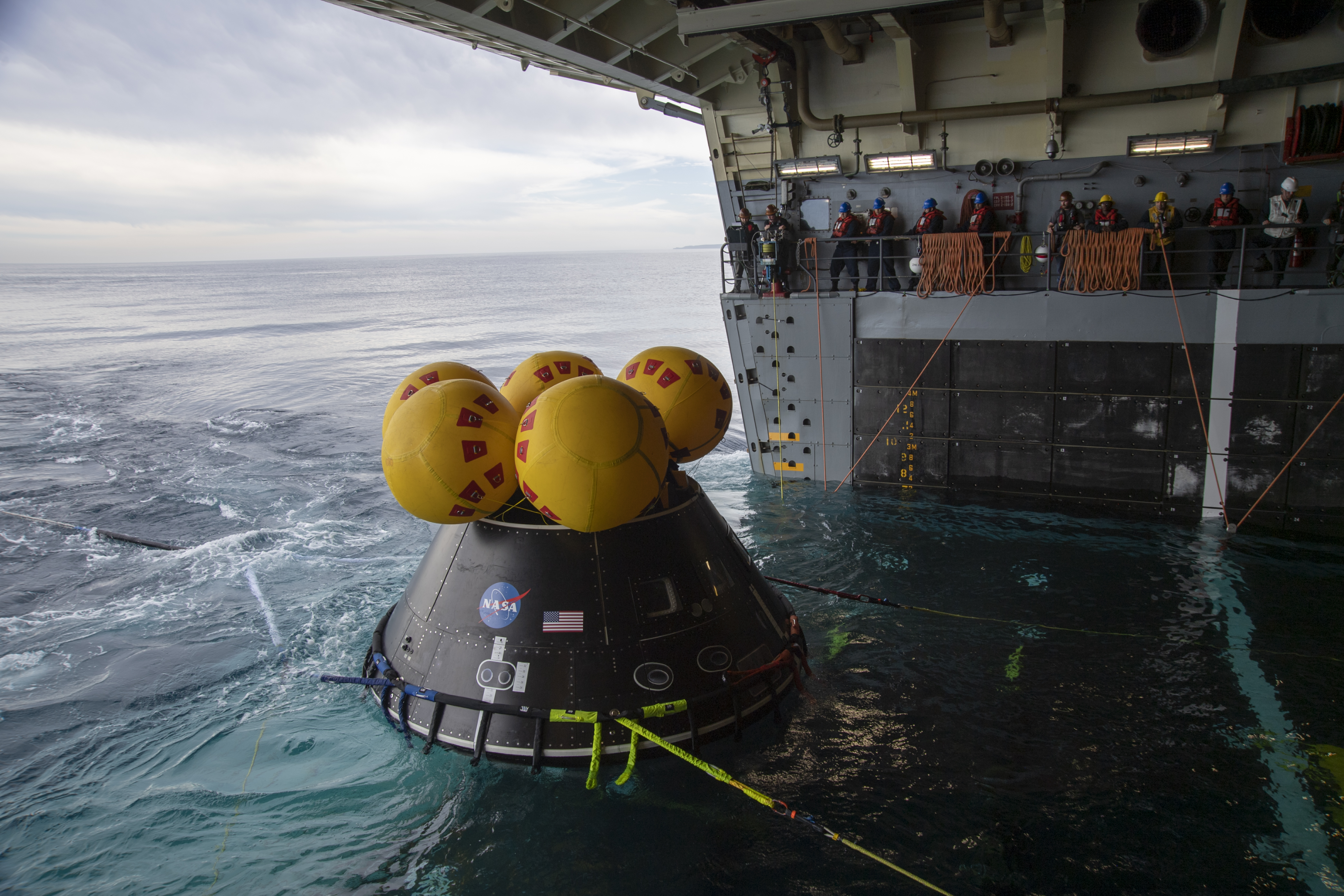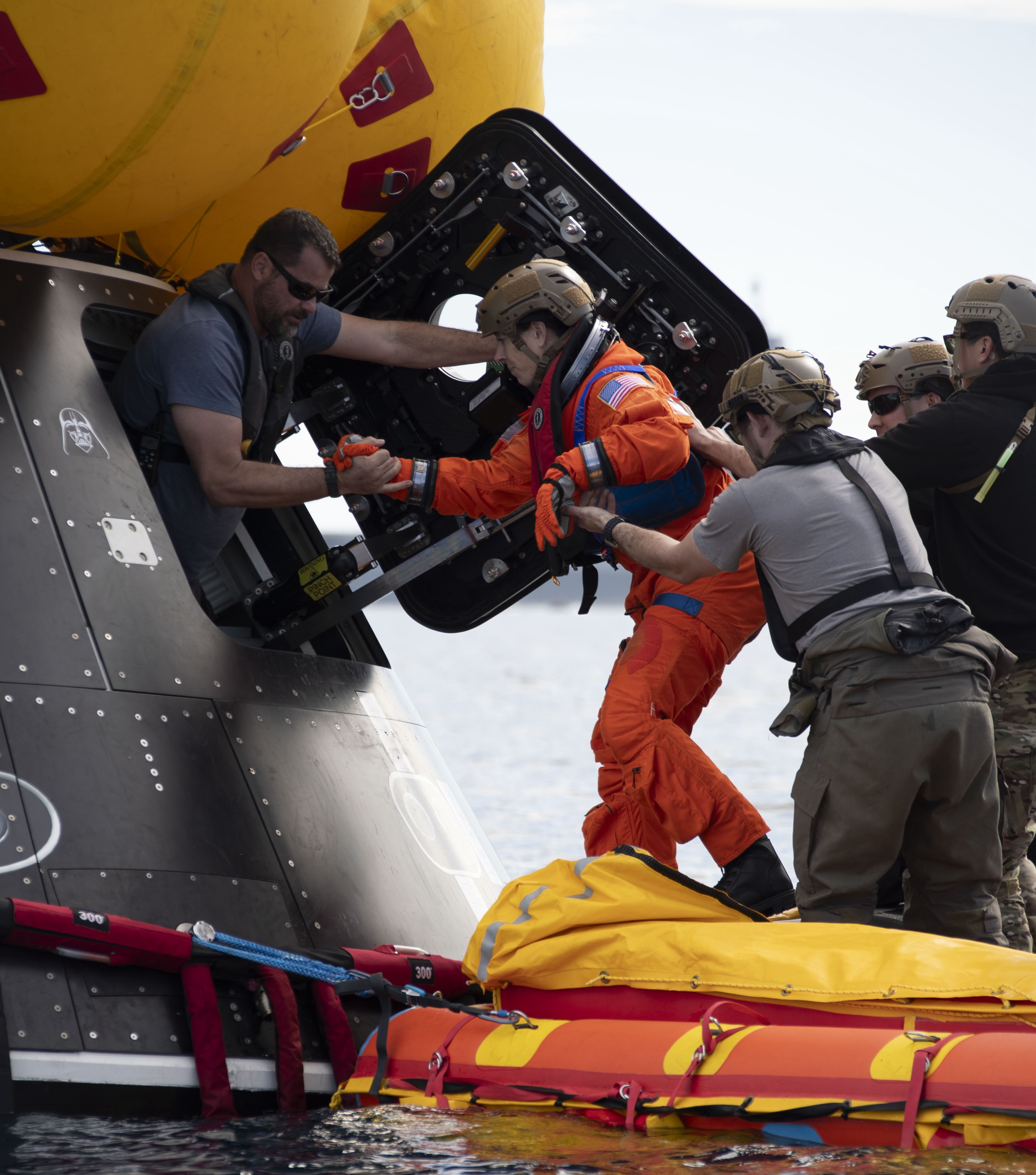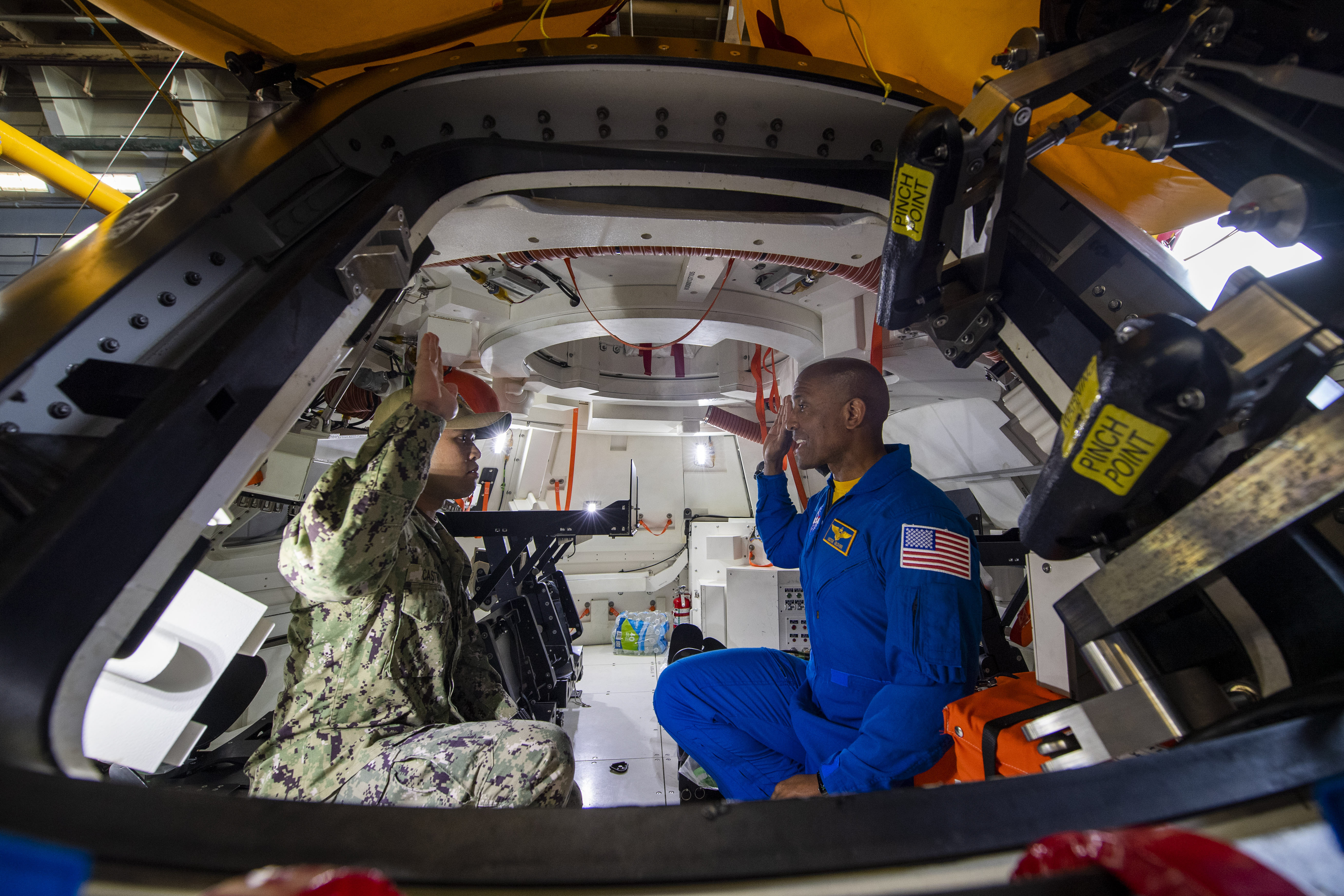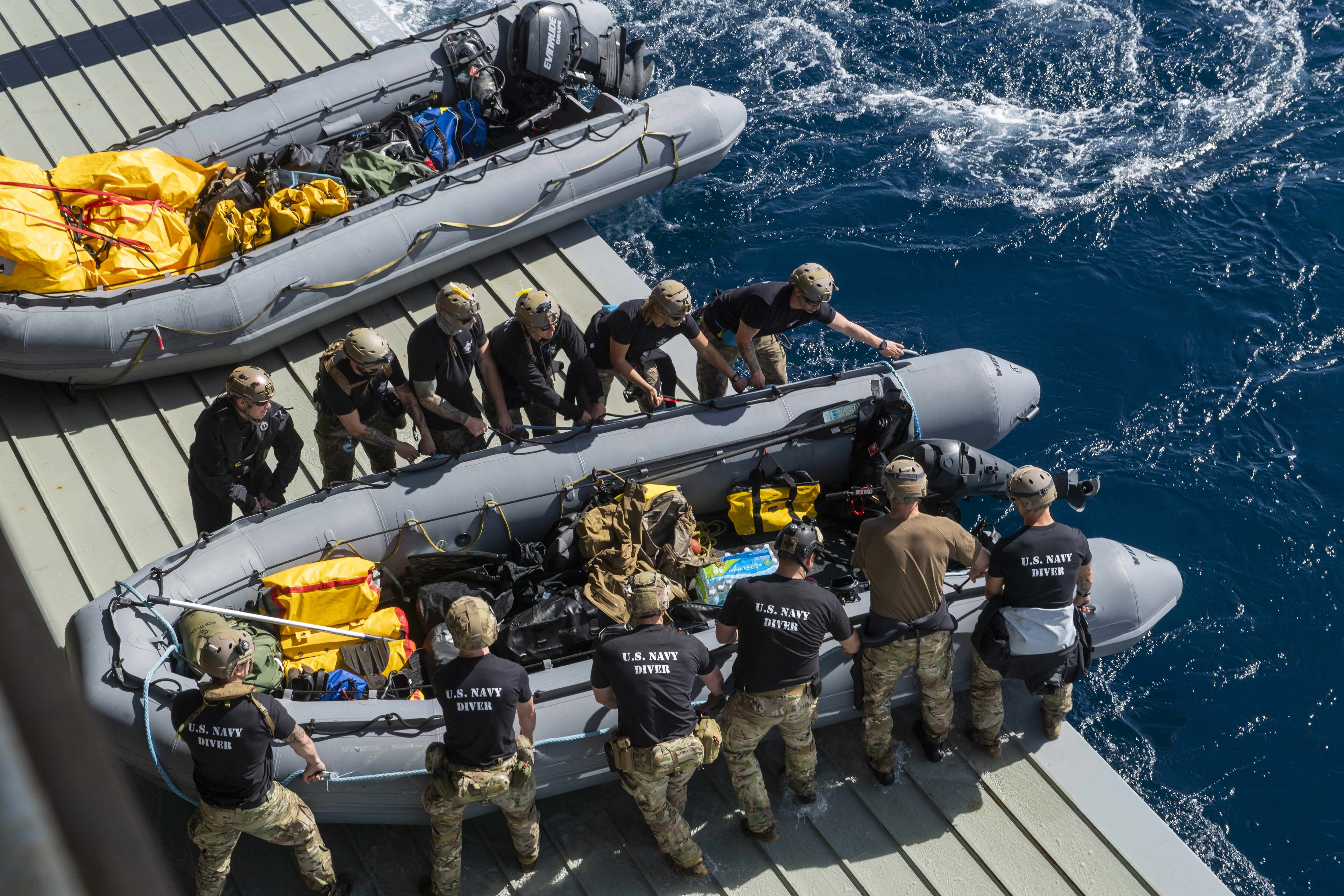
When NASA’s Orion spacecraft splashes into the Pacific after its planned lunar mission next year, the first people the astronauts will see will be a bunch of sailors.
That recovery task requires intricate planning, coordination and training, the latest of which wrapped up this week with the first joint training exercise at sea involving the astronauts who will crew the planned Artemis missions to the Moon. Four astronauts – including two Navy captains – are training for the Artemis II mission that will send them on a 10-day trip orbiting the moon next year. It’s a critical step for NASA’s planned Artemis III mission, which would be the first crewed launch to land on the moon since the Apollo 17 mission in 1972.
During the weeklong Underway Recovery Test 11, amphibious transport ship USS San Diego (LPD-22), Navy divers, helicopter crews and medical staff recovered the astronauts from a test crew craft following a simulated splashdown into the Pacific and then hauled the training spacecraft into San Diego’s well deck.
URT-11 focused on day and night open-ocean tests, with the test craft aboard San Diego, training with the recovery teams and procedures for the splashdown for next year’s scheduled mission to the Moon. The upcoming Artemis II launch, planned for September 2025, will be crewed by mission commander Navy Capt. Reid Wiseman, pilot Navy Capt. Victor J. Glover and mission specialists Christina Koch and Jeremy Hansen, the latter with the Canadian Space Agency.
ULT-11, the latest in a series of planned drills with the Navy and NASA’s Exploration Ground Systems ahead of the September 2025 launch, was “very successful,” said Lili Villareal, NASA’s landing and recovery director.
“We continue to validate our procedures that we can safely recover the Artemis II astronauts from the Orion spacecraft into the recovery vessel, along with bringing the spacecraft into the well deck,” Villareal said at a press briefing Wednesday beside USS San Diego, which is berthed at Naval Base San Diego. The test module – the mock-up is similar in size as the actual Orion spacecraft – sat in the ship’s well deck.

“It’s a highly choreographed activity that requires a lot of teams and hardware to come together to bring our Artemis astronauts home,” she said.
After splashdown, that starts with Navy divers who meet the capsule and help astronauts out and onto a raft to be hoisted into Navy helicopters, recovering them, one by one, to the support ship, where the medical department evaluates the astronauts. Then, the joint Navy-NASA team recovers the capsule onto the ship, which returns to the San Diego base.
Navy ship crews have been constant partners with NASA through decades of manned space flight.
Last year, USS Portland (LPD-27) joined Navy crews in recovering the Orion space capsule – sans astronauts – after it splashed down in the Pacific off Baja California. That Artemis I lunar mission had sent the capsule on a 25-day trip to the Moon, where it orbited 1.3 million miles in space. “These tests are what we need to make sure that the Artemis II is just as successful,” Villareal said.
A decade ago, the crew of San Diego participated in recovering the first flight test of the Orion capsule, following its launch from Cape Canaveral, Fla.
Capt. David Walton, San Diego’s commander, noted how the LPDs, with their flight deck, extensive well deck and large medical department, are well suited to conduct the joint recovery mission. This time, Walton noted, URT-11 took on an exciting note as San Diego hosted the astronauts.

The at-sea training also wowed the astronauts. Wiseman recounted getting hoisted off the ship, dangling from a hovering helicopter at night. “This is crazy. This is off of movies, and we’re living it every day,” he said at the briefing.
The upcoming Artemis missions are focused on the Moon, but the greater goal is to pave the way for Mars exploration, Wiseman said. “It’s humans on Mars. It’s humans working on and around the Moon. When we put our minds together to go out and do something – as a planet, all cooperating – that is our goal. To go out and to explore our solar system like humans do. What’s around the next corner? We want to know. We are excited to be the first crew in over 50 years to go out to the moon and back, 50,000 miles out and 250,000 miles back.”
“When we land, it’ll be an LPD from the U.S. Navy with survival swimmers coming down the hoist, maybe in the night,” he said.
The Artemis II mission will be notable for another reason. The four-astronaut crew will be the first to leave low-Earth orbit and fly around the Moon with a female astronaut, a Black astronaut and a Canadian astronaut.
“It doesn’t matter if you’re a first if there’s no seconds, thirds and fourths,” Glover, a veteran fighter and test pilot, said during the briefing. “So that’s really what I think about is making sure we do the best at our job so that the American people and our international partners continue to have faith in their public space agencies so we can keep going and exploring further.” Glover had piloted a 2020-2021 SpaceX mission to the International Space Station and, during 168 days in space, did four spacewalks.

“It’s important to bring anyone who has innovative ideas, anyone who has a desire to contribute, to this team,” added Koch, who’s tallied the longest time in space by any woman during a 2019-2020 mission to the space station. “That’s what makes us successful and that’s what is really worth celebrating.”
The latest underway training with the Navy crews helped work through problems such as broken parts and rougher seas than expected, Wiseman said. “You never understand the problems that nature can throw at you,” he said.
The next training drills, ULT-12, will be the mission certification run before the actual lunar mission, Villareal said. The joint NASA-Navy training includes Navy’s Expeditionary Strike Group 3, U.S. Space Command and other Department of Defense units.





